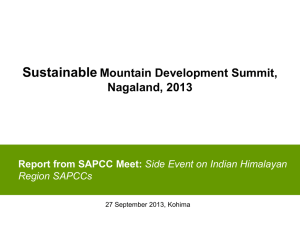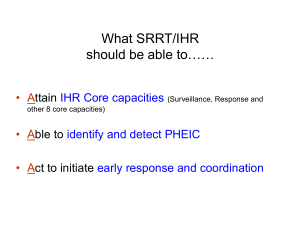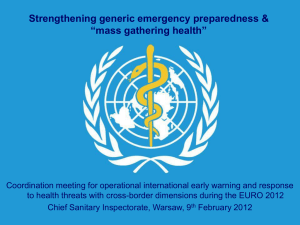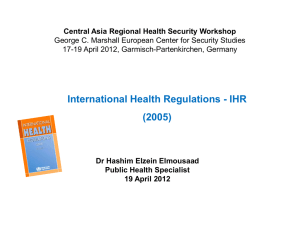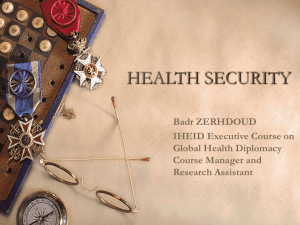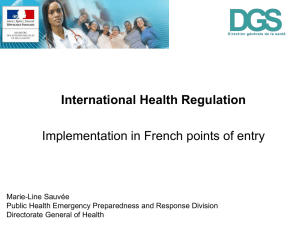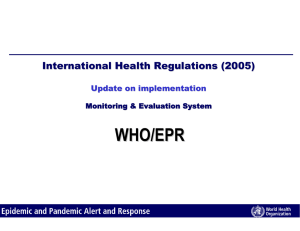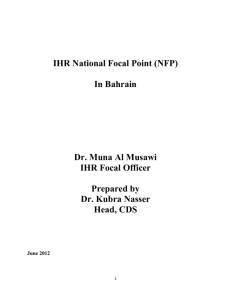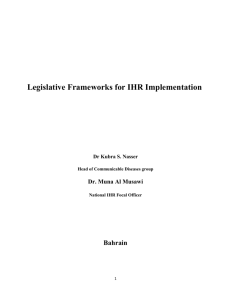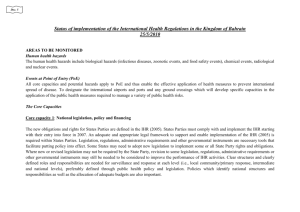IHR Roles and Responsibility
advertisement
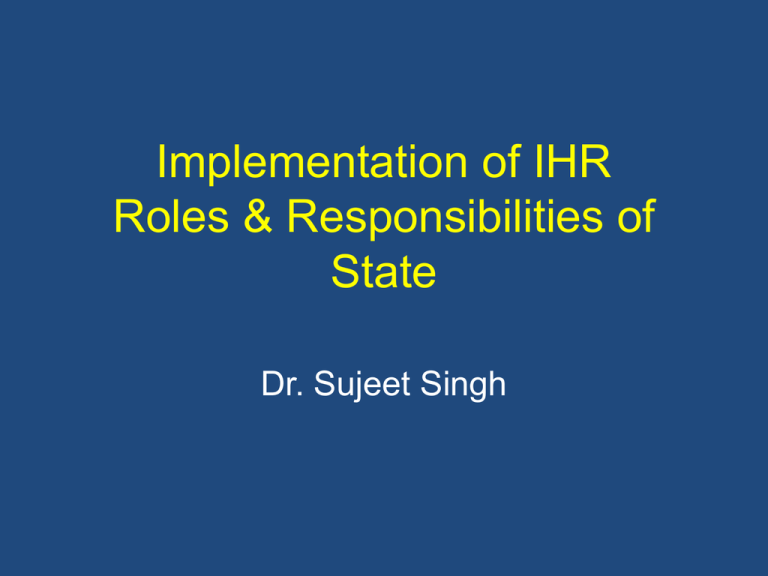
Implementation of IHR Roles & Responsibilities of State Dr. Sujeet Singh Broad Areas • • • • • IHR requirements Key areas Activities for effective implementation Core capacities Roles & responsibilities What are IHRs? An international legal instrument, legally binding on all WHO Member States who have not rejected them • IHR (1969): Objective: Maximum security against international spread of diseases with minimum interference to world traffic Scope: Only 3 diseases (Cholera, plague, yellow fever) Limitations: Dependence on affected country to notify; Lack of mechanisms for collaboration between WHO and affected country Emerging Pathogens and IHR • Smallpox, cholera, plague subject to regulations till 1970s- Now eradicated/ controlled. • IHR were not fulfilling purpose as evident from plague outbreak (1994), SARS outbreak ( 2003) and Influenza A H1N1 (2009) • Emergence and re- emergence of diseases of International concern in last decade Recent Outbreaks • In other countries – SARS – Avian Influenza – Influenza A H1N1 • In India – Plague – DHF – PHEIC related to disasters, Chemical accident, radiological SARS Outbreak (2003) • IHR 1969 with provision for reporting for 3 diseases only • No IHR provisions for SARS – China • Delay in cause detection, mode of spread etc. • Surveillance & response in each country were different ( Mostly Reactive response) – Entry screening (1.20 lac pax. screened per week) – Isolation and quarantine – Lab. Testing & prophylaxis/treatment for cases and contacts – Reporting & documentation • Highlighted the importance and need for revision of IHR 1969 Influenza A H1N1 • IHR (2005) in place (better planned) – Guidelines on surveillance & response – Uniform procedures - entry screening, contact tracing, chemoprophylaxis, PPEs etc. – Isolation and sample for Laboratory tests – Guidelines for management of case & suspects, disinsection & use of PPEs – Periodic review of strategy by daily reporting IHR (2005) Document • 66 Articles organized in X Parts • • 9 Annexes Annex 1 – Core Capacity Requirements for Surveillance & Response, and for Designated Airports, Ports and Ground Crossings Annex 2 – Decision Instrument for Assessment & Notification of Events that may constitute a Public Health Emergency of International Concern • • Available on Website: http://www.who.int/csr/ihr/en/ What is New in IHR (2005) • Concept of National focal point • Covers all dangerous diseases both new and existing PHEIC • WHO has the mandate to verify rumors, news from print/electronic media of disease / outbreaks • Obligation to develop core capacity both at country level as well as ports/ airports • Provision for WHO assistance for early diagnosis • Provision of dispute solving through court of arbitration • Covers notification for chemical & radio-nuclear events as well 10 Major Obligations for Member States Designation of National IHR Focal Point Legal & administrative framework Response Major Obligations Assess events & notify potential PHEIC Core capacities to detect, report and respond Responsibility of National Focal Point (NCDC) • To notify PHEIC to WHO • To respond to requests for verification of information of such events. • Support field investigations, provide early diagnosis and provide technical guidance to states for timely and effective response to PHEIC • Co-ordination with state units and WHO 12 Public Health Emergency of International Concern (PHEIC) • An extraordinary public health event which constitutes a public health risk to other countries through international spread of disease potentially requires a coordinated international response “Disease means an illness or medical condition, irrespective of origin or source that presents or could present significant harm to humans” Determination of PHEIC – 4 criteria Unusual or Unexpected Event Event resulting in Serious Public Health Impact Event with significant risk of international spread Event with significant risk of international travel or trade restriction Any event irrespective of origin & source meeting any 2/more criteria shall be considered as PHEIC & notified to WHO under IHR (2005) Notification The IHR(2005) requires notification of all events which may constitute PHEIC within 24 - 48 hours To respond to requests for verification of rumors / news received from print media or other sources No specified list of diseases (algorithm provided) 15 Key Areas for effective implementation • Legal provision – IHR (legal & technical) » National - Epidemic Disease Act -1987 » Disaster Management Act 2005 » Draft Public Health (prevention, control and management of epidemics, bioterrorism and disasters) Bill provides for prevention, control & management of epidemics and public health consequenses of disasters » Indian Aircraft (public Health) Rules, 1954 & Indian Port Health rules, 1955 Key Areas (contd.) – Assessment & strengthening of core capacities at national/state/districts – nodal officers/RRTs (multidisciplinary) – Trained manpower development – contingency plan – SOPs for procedures – case management, screening, contact tracing, chemoprophylaxis, PPEs etc. – Facilities for isolation, quarantine and case management – laboratory/hospital back-up support – Risk assessment and Communication network – Periodic review, data processing and reporting Activities undertaken for Effective Implementation of IHR (2005) • Activities at National level • Activities by State Governments/ UTs and District Authorities • Activities related to the Airports/ Ports/ Ground Crossings Activities at National Level • • • • • National IHR focal point designated - NCDC Coordination with WHO & states/districts Designation of Nodal officers Core capacity building Increased awareness about IHR among health administrators and professionals • Surveillance & response capacity (RRT) • Enhanced Satellite based disease surveillance • Strengthening laboratory network National Level Activities • Develop RRT guidelines, laboratory & computer manuals, and training materials • Train State Rapid Response Teams • Strengthen & network National & Regional laboratories • Establish rapid communication network • Technical review, co-ordination, monitoring & evaluation Activities – State/UT Govts & District Authorities • State & District IHR focal points designated • Reporting by State/District to National Focal Point as per IHR • IHR in IDSP trainings • Surveillance & response capacity enhanced – Influenza A H1N1 IDSP Objectives • Establish early warning mechanism • Laboratory strengthening & networking for surveillance & rapid confirmation of diagnosis • Effective use of surveillance data using rapid means for communication • Institute appropriate & timely response for prevention & control of outbreaks Events that may constitute PHEIC Alert & Response Operations Detection Verification Risk assessment Response Surveillance & response: capacities required at each level - Event Regional & International level National level Intermediate level Local level alert - verification - Assessment - Intl. response - Assessment - Notification - P.H. response - Confirmation - Response - Assessment - Detection of event - Reporting - Controlling At the National Level • Assessment and notification. The capacities: • To assess all reports of urgent events within 48 hours; and • To notify WHO immediately • To confirm the status of reported events and to support or implement additional control measures; and • To assess reported events immediately and, if found urgent, to report all essential information to the national level. For the purposes of this Annex, the criteria for urgent events include serious public health impact and/or unusual or unexpected nature with high potential for spread. Activities on the part of State Governments/UTs and District Authorities • Designation of IHR focal points – 24x7 accessibility • Assessment and strengthening of disease surveillance & response capacity as per IHR • Evaluation & strengthening of laboratory capacities (inventory of regional /national labs) • Evaluation & strengthening of isolation facilities & infection control practices • Mechanism for rumour verification • Awareness reg. information to be reported to NFP Activities on the part of State Governments/ UTs and District Authorities contd... • Preparation and periodical updating of public health contingency plans • Involvement of private sector and professional organizations (e.g. IMA) for disease surveillance activities • APHOs/ PHOs/ Ground crossings be included in state surveillance committees • Identification of high-risk areas near international borders and programme for cross-border control of diseases Activities (contd.) State Governments/ District • Linkages of IDSP/NFP with all state/ district HQs • Nodal officers to be identified in: – Designated hospitals, laboratories and various pest/ vector control agencies – State Health Directorates, District Health Authorities – Local municipality, cantonment board, other relevant agencies – Ministries of Civil Aviation, Shipping, Surface transport, Agriculture (veterinary dept.), Home Affairs, Tourism, Railways – Customs, Immigration, AAI – AOC, Association of shipping agents – CISF Activities related to the Airports/ Ports/ Ground Crossings • Designation of Airports/ Ports/ Ground Crossings IHR Focal Points • Training of technical staff on IHR • Assessment & strengthening of capacities at designated entry/ exit points • Awareness about information to be reported to NFP • Referral system for medical care services • Creation of new public health units • Improve infrastructure of quarantine centers • District IDSP lab be designated for each APHO/ PHO • Provision of entomologist for vector surveillance & control activities District Responsibilities • Identify district RRT members – multidisciplinary • Train Medical Officers & PMWs – event reporting – numbers of human cases and deaths, conditions affecting the spread of the disease and the health measures employed and Clinical descriptions • Modernize & computerize District Epid. Cell • Identify & strengthen District Labs – SOPs for sample collection/transportation, media • Reporting of events / PHEIC from district/state • Response plan National level response • To determine rapidly the control measures required to prevent domestic and international spread; • To provide support through specialized staff, laboratory analysis of samples (domestically /regional collaborating centres) and logistical assistance (e.g. equipment, supplies and transport); • To provide on-site assistance to supplement local investigations; • Coordination / liaison with other relevant ministries/departments/NGOs • Coordination with senior health officials to approve rapidly and implement containment and control measures • To establish links with hospitals, clinics, airports, ports, ground crossings, laboratories etc.for the dissemination of information and recommendations received from WHO regarding events • To establish, operate and maintain a national public health emergency response plan, including the creation of multidisciplinary/ multisectoral teams to respond to PHEIC State Level Capacities • To detect events involving disease or death above expected levels for the particular time and place in all areas within the territory of the State Party; and • To report all available essential information immediately to the appropriate level of healthcare response. • At the community level, reporting shall be to PHC/CHCor the appropriate health personnel. At the primary public health response level, reporting shall be to the district/State or national response level, Essential information includes : • Clinical descriptions, laboratory results, sources and type of risk, numbers of human cases and deaths, conditions affecting the spread of the disease and the health measures employed; and • To implement preliminary control measures immediately. Laboratory strengthening • • • • • • • • • Identify and strengthen labs at National, Regional,State and district Intrasectoral, intersectoral and international networking SOPS & facilities for sample collection/storage/transportation Outbreak Investigation Kits Inventory of Biosafety levels labs:BSL-2/BSL-3/ BSL-4 Focus on Epidemic-prone and EIDs Arrangements for diagnostic kits and reagents Mechanism of release of reports & documentation Define role of private labs Laboratory Roles • • • • • • • Focus labs for neglected areas: TSS,Food Posionings Labs - Diseases in Animals Environmental sampling :Air,food, water Water quality monitoring Mobile labs/ Portable labs / Temporary labs Lab-based surveillance before, during and after the disasters Plan for processing of non-conclusive samples-newer pathogens? Where to send? • Ensure availability PPEs, disinfectants, chemo/immunoprophylaxis Networking & Web-based surveillance - Interactive website www.nicd.org, is operational for online data entry – Directory of NSPCD official at centre, state and districts is available Web-based Surveillance SUMMARY • Action plan for (Proactive Response) – Core capacity development - IHR module for PHEIC – Training of manpower including field staff on Surveillance, response & case reporting – Resource planning –drugs, reagents, PPEs – Intersectoral coordination – Laboratory support – Real time exercises – Retrospective Epidemiological study of disasters in the area • Collaboration of plan with allied agencies, areas and states THANKS
